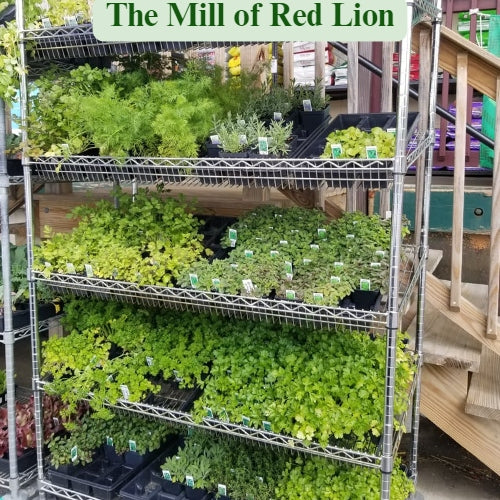Choosing the Right Containers and Herbs

Here are some tips on selecting and preparing containers for herb growing:
-
Choose a container that is large enough to accommodate the herb's root system.
-
Use a container with drainage holes to ensure proper drainage.
-
Ensure your planters are cleaned. If reusing planters, disinfect them with a mild bleach solution and rinse them well.
-
Select a high-quality potting soil that is well-draining and nutrient-rich.
-
Add organic matter, such as compost or aged manure, to the soil to improve soil fertility.
-
Pair the herbs in containers by their preference for light and moisture.
-
Consider mixed pots of herbs and other companion plants like flowers and vegetables for natural pest control, attracting beneficial insects and providing interest and aesthetic value.
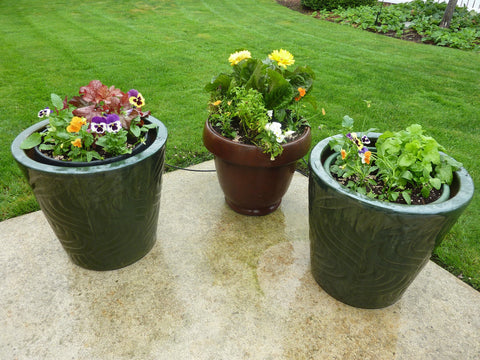
Caring for Your Herb Plants
-
Watering: Herbs need regular watering to stay healthy, but it's important not to overwater them. Be sure to water your herbs thoroughly when the top inch of soil feels dry to the touch.
-
Fertilizing: Container-grown herbs benefit from regular fertilization. You can use a balanced, all-purpose fertilizer or a fertilizer specifically
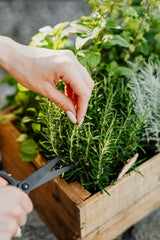 formulated for herbs.
formulated for herbs. -
Pruning: Regular pruning helps to keep your herbs healthy and productive. Be sure to remove any dead or yellowing leaves and trim back any leggy growth.
-
Pest Control: Pests like aphids, mites, and whiteflies can damage your herbs. To control pests, you can use insecticidal soap or neem oil, or try companion planting with marigolds and nasturtiums.
-
Harvesting: Regular harvesting helps to promote healthy growth and keeps your herbs from becoming too woody or leggy. Be sure to harvest your herbs regularly and use them in your favorite dishes.
Growing herbs in containers is an excellent way to enhance your culinary skills and enjoy fresh, flavorful ingredients right at home while also improving the aesthetic value of your outdoor living space. Herbs are versatile plants that are easy to grow and maintain. With the right selection of herbs, proper container selection and preparation, companion planting, and maintenance, you can have a thriving container garden full of delicious and healthy herbs. So why not try your hand at container gardening and start enjoying the many benefits of fresh herbs today!
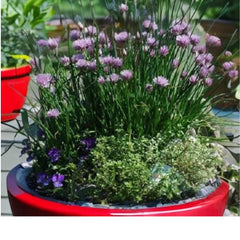
Companion Planting with Herbs
Companion planting is a technique that involves growing certain plants together to benefit each other. When it comes to growing herbs in containers, companion planting can help to deter pests and attract beneficial insects. Some of the best companion plants for herbs include:
-
Calendula: Calendula is a bright and cheerful flower that's also a great companion plant for vegetables. It attracts beneficial insects like ladybugs and lacewings while also repelling pests like aphids and whiteflies.
-
Nigella: Nigella, also known as love-in-a-mist, is a delicate flower that's easy to grow and also helps to repel pests like aphids and spider mites.
-
Sweet Alyssum: Sweet alyssum is a fragrant and attractive flower that's a great companion plant for vegetables like lettuce and cabbage. It attracts beneficial insects like hoverflies and lacewings, which prey on aphids and other pests.
-
Borage: Borage is a beautiful and easy-to-grow flower that's also a great companion plant for vegetables. It attracts beneficial insects like bees and ladybugs, while also repelling pests like tomato hornworms.
-
Marigolds: Marigolds are a great companion plant for herbs and vegetables alike. They deter pests like aphids, whiteflies, and nematodes, while also attracting beneficial insects like ladybugs and lacewings.
-
Nasturtiums: Nasturtiums are another great companion plant that attracts beneficial insects and can help to deter pests. Nasturtiums are also edible and used as a culinary garnish.
-
Pansies: Pansies are a beautiful and colorful companion plant that can help to attract bees and other pollinators to your herbs. In mixed planters with vegetables and herbs, they provide color and fill in bare areas.
10 Recommended Herbs for Container Gardening
There are various herbs that are well-suited for container gardening. These herbs can be used fresh or dried to add flavor to your dishes. Here are some facts about each of these popular herbs:
Basil
Basil is a popular herb that is commonly used in Italian cuisine such as pesto, tomato sauce, and Caprese salad. It is an annual herb that is easy to grow from seed or transplant and grows well in containers. Basil prefers full sun and moist but well-drained soil. Provide plenty of light and it is best to pinch off the flowers as they form to encourage bushier growth and to extend the life of the plant. Some popular varieties of basil include Sweet Basil, Genovese Basil, and Thai Basil.
Parsley
Parsley is another versatile herb that is commonly used in many dishes including salads, soups and stews, or as a garnish for your favorite dishes.It is a biennial herb that is easy to grow from seed or transplant and is perfect for container gardening It prefers a slightly cooler growing environment and good air circulation. Parsley prefers partial shade and moist soil. Parsley is also a great companion plant that attracts beneficial insects to your garden. Some popular varieties include Flat-leaf Parsley and Curly Parsley.
Chives
Chives are a mild-flavored member of the onion family and are a great addition to many dishes such as salads, soups, potatoes, and omelets. They are a perennial herb that is easy to grow from seed or transplant and do well in containers and indoors. Chives prefer full sun to partial shade and well-drained soil. Chives are also a great companion plant that deters pests from your garden. Some popular varieties of chives include Garlic Chives and Onion Chives.
Thyme
Thyme is a fragrant and flavorful herb that is commonly used in Mediterranean cuisine and is perfect for seasoning meats, soups and stews. It is a perennial herb that is easy to grow from seed or transplant. Thyme prefers full sun and well-drained soil. Thyme is also a great companion plant that deters pests from your garden. Some popular varieties of thyme include Lemon, French, and English Thyme. It's also very hardy and can tolerate a range of temperatures and growing conditions.
Rosemary
Rosemary is a fragrant herb that is commonly used in Mediterranean cuisine. Use rosemary to flavor meats, potatoes and bread. Some popular varieties of rosemary include ARP, Hill Hardy, Salem, Spice Island, and Gorizia. It is a perennial herb that is easy to grow from seed or transplant. Rosemary prefers full sun and well-drained soil making it a perfect container plant. It is also a great companion plant that deters pests from your garden. Hardy to zone 7b rosemary can remain outdoors in winter. Just protect it if the weather turns very cold. What normally bothers Rosemary in the winter is moisture. It originates from the Mediterranean region so harsh wet winters are not conducive to healthy plants
Mint
Mint is a perennial herb that is easy to grow and maintain. It can become invasive in a garden plot, so is best grown in a container where it can be controlled. It prefers partial shade and moist soil. There are many different varieties of mint, including peppermint, spearmint, and chocolate mint. Mint is a great addition to teas, cocktails, and desserts.
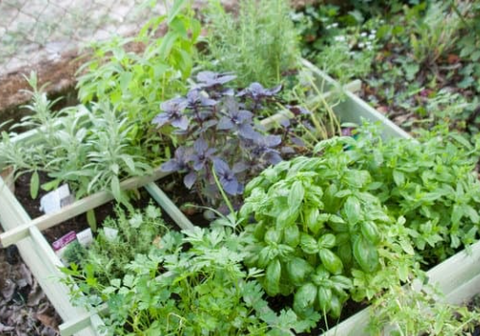
Sage
Sage is a perennial herb that is commonly used in Mediterranean and Middle Eastern cuisine. It prefers full sun and well-drained soil. Sage is known for its distinct flavor and aroma, and is often used in stuffing, meat dishes, and sauces.
Oregano
Oregano is a perennial herb that is commonly used in Italian and Mediterranean cuisine. It prefers full sun and well-drained soil. Oregano is known for its strong, spicy flavor and is often used in pasta dishes, pizza, and tomato-based sauces.
Cilantro
Cilantro is an annual herb that is commonly used in Mexican and Asian cuisine. It prefers partial shade and well-drained soil. Cilantro is known for its distinctive flavor and is often used in salsa, guacamole, and curries.
Dill
Dill is an annual herb that is commonly used in Scandinavian and Eastern European cuisine. It prefers full sun and well-drained soil. Dill is known for its distinct flavor and aroma and is often used in pickling, salads, and seafood dishes.

Here are Four Delicious Recipes Using Fresh Basil, Cilantro, Thyme, and Rosemary:
Basil Pesto Pasta

- 1 lb. spaghetti or other pasta
- 2 cups fresh basil leaves, packed
- 1/2 cup grated Parmesan cheese
- 1/2 cup olive oil
- 1/3 cup pine nuts
- 3 cloves garlic, minced
- Salt and pepper, to taste
- Cook the pasta according to package directions.
- In a food processor, pulse the basil, Parmesan cheese, olive oil, pine nuts, and garlic until smooth.
- Season with salt and pepper to taste.
- Toss the cooked pasta with the pesto sauce.
- Serve hot and enjoy!
Cilantro Lime Chicken
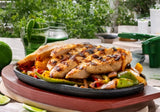
- 4 boneless, skinless chicken breasts
- 1/4 cup fresh cilantro, chopped
- 2 limes, juiced
- 2 garlic cloves, minced
- 1/4 cup olive oil
- Salt and pepper, to taste
- In a small bowl, whisk together the cilantro, lime juice, garlic, olive oil, salt, and pepper.
- Place the chicken breasts in a large zip-top bag and pour the marinade over the chicken.
- Seal the bag and refrigerate for at least 30 minutes (or up to 24 hours).
- Heat a grill or grill pan over medium-high heat.
- Grill the chicken for 6-8 minutes per side, or until cooked through.
- Serve hot and enjoy!
Thyme Roasted Potatoes
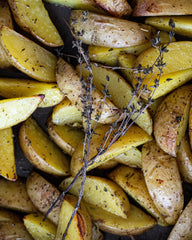
- 2 lbs. baby potatoes, halved
- 2 tbsp. fresh thyme leaves
- 2 garlic cloves, minced
- 1/4 cup olive oil
- Salt and pepper, to taste
- Preheat the oven to 400°F.
- In a large bowl, toss the potatoes with the thyme, garlic, olive oil, salt, and pepper.
- Spread the potatoes in a single layer on a baking sheet.
- Roast for 25-30 minutes, or until the potatoes are golden brown and crispy.
- Serve hot and enjoy!
Rosemary Garlic Roast Beef
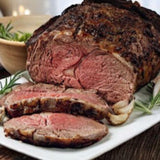
- 3 lbs. beef roast
- 1/4 cup fresh rosemary leaves, chopped
- 3 garlic cloves, minced
- 1/4 cup olive oil
- Salt and pepper, to taste
- Preheat the oven to 350°F.
- In a small bowl, mix together the rosemary, garlic, olive oil, salt, and pepper.
- Rub the mixture all over the beef roast.
- Place the beef roast in a roasting pan and roast for 1 1/2 to 2 hours, or until the internal temperature reaches 135°F for medium-rare.
- Let the roast rest for 10 minutes before slicing and serving.
- Enjoy!
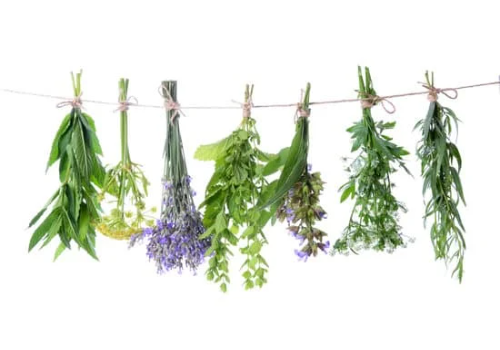
The Mill has a variety of herbs available to help you get a kitchen herb garden started for a delicious source of fresh healthy flavors this summer!
